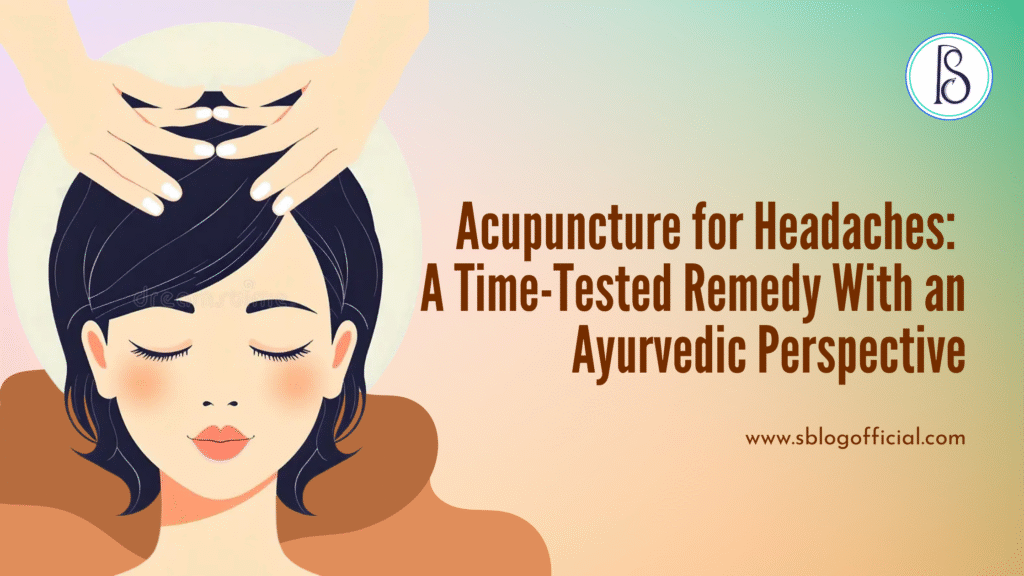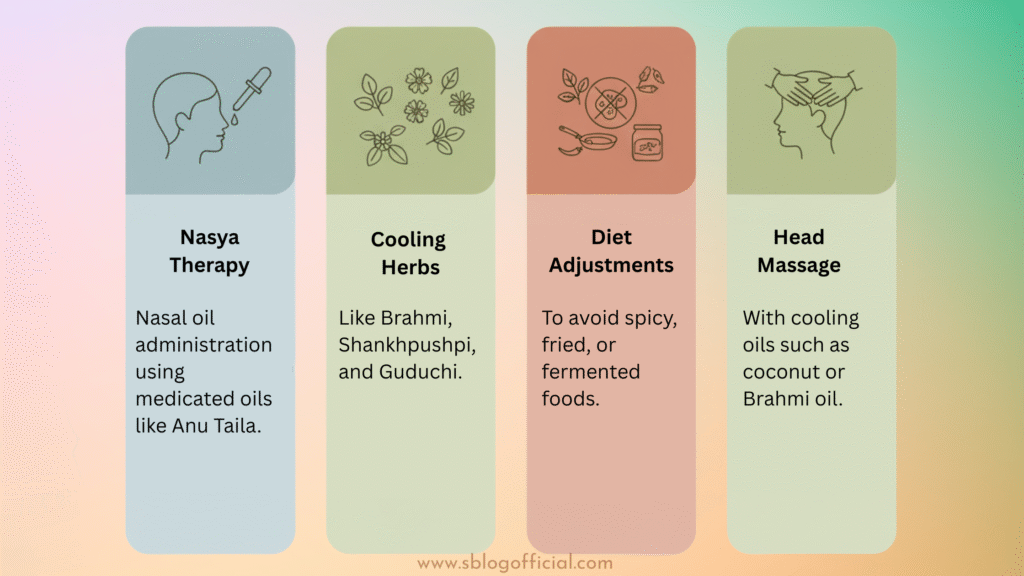
Headaches, whether mild or severe, can disrupt the harmony of our body and mind. In both Traditional Chinese Medicine (TCM) and Ayurveda, pain in the head is not just a symptom, but a signal of inner imbalance. While modern medicine often treats headaches with quick painkillers, ancient healing systems like acupuncture for headaches and Ayurveda take a deeper, holistic approach.
If you’ve been searching for lasting relief, this guide will explore how acupuncture for headaches, complemented by Ayurvedic insights, can provide safe, natural, and long-term relief from head pain. With over 45 million people in the UK suffering from headaches annually, and tension headaches affecting approximately 80% of adults at some point, the need for effective, non-pharmaceutical treatments has never been greater.
Acupuncture for Head Pain: A Holistic Science
Acupuncture for headaches is a 2,500-year-old healing art based on balancing the flow of Qi—the vital energy in the body, by stimulating specific points using thin acupuncture needles. Research has shown that acupuncture for headaches can be as effective as medication for some patients, with fewer side effects and longer-lasting results.
According to TCM, when Qi becomes blocked in the head or neck meridians, it leads to pain and tension. Similarly, Ayurveda attributes headaches to an imbalance of doshas, especially:

- Vata (dryness, nerve irritation)
- Pitta (inflammation, heat)
- Kapha (congestion, heaviness)
Acupuncture for head pain works by unblocking stuck energy (like balancing vata and pitta), reducing inflammation, and restoring harmony in the nervous and vascular systems. Studies indicate that regular acupuncture treatments can reduce headache frequency by up to 50% within three months of consistent therapy.
Also Read- Holistic Health & Healing | A Complete Guide to Natural Wellness
Understanding Headaches Through Ayurveda and TCM
Both Ayurveda and TCM classify headaches into types, and understanding your headache pattern helps determine the most effective acupuncture for headaches approach:
| Type of Headache | Ayurvedic Dosha | TCM Element | Common Symptoms |
| Tension Headache | Vata | Wind | Tightness, dry eyes, fatigue |
| Migraine | Pitta | Liver Fire | Throbbing pain, nausea, light sensitivity |
| Sinus Headache | Kapha | Dampness | Pressure, congestion, dull pain |
| Cluster Headache | Pitta-Vata | Liver Yang Rising | Intense one-sided pain, watery eyes |
This overlap makes acupuncture for headaches and Ayurvedic therapies like Shirodhara, Nasya, and herbal formulations excellent complementary treatments for lasting relief.
Acupuncture for Migraine Headaches: What Ayurveda Adds
Migraines are intense headaches often accompanied by nausea, visual disturbances, or dizziness. Acupuncture for migraine headaches has been shown to reduce severity, frequency, and the need for medications. Clinical trials have demonstrated that patients receiving acupuncture experience 3.2 fewer migraine days per month compared to those receiving standard care alone.
Ayurvedic Perspective:
In Ayurveda, migraines are often seen as Suryavarta, a condition linked with Pitta dosha rising during the daytime. Treatments include:

- Nasya therapy (nasal oil administration using medicated oils like Anu Taila)
- Cooling herbs like Brahmi, Shankhpushpi, and Guduchi
- Diet adjustments to avoid spicy, fried, or fermented foods
- Head massage with cooling oils such as coconut or Brahmi oil
Pairing acupuncture for headaches at points like GB20 (base of skull), LI4 (hand), and ST8 (temple) with cooling Ayurvedic routines can dramatically reduce migraine recurrence. Many practitioners recommend combining both approaches for optimal results, with patients reporting up to 70% reduction in migraine intensity.
Also- what herbs have the most health benefits | Potent Remedies
Chinese Remedies and Ayurvedic Herbs for Headaches
While Chinese remedies for headaches include cupping, herbal formulas, and moxibustion, Ayurveda offers potent herbal and panchakarma-based therapies for the same issue.
Chinese Herbs:
- Chuan Xiong Cha Tiao San – disperses wind and relieves pain
- Tian Ma – calms liver wind and settles the mind
- Bai Zhi – expels wind and opens nasal passages
- Ju Hua – clears heat and benefits the eyes
Ayurvedic Herbs:
- Brahmi (Bacopa monnieri) – calms the mind and supports cognitive clarity
- Tagara (Valeriana wallichii) – balances vata and supports deep sleep
- Jatamansi (Nardostachys jatamansi) – neuroprotective and calming
- Ashwagandha (Withania somnifera) – reduces stress and supports the nervous system
- Yashtimadhu (Glycyrrhiza glabra) – anti-inflammatory and soothing
Both traditions emphasize liver detoxification, mental clarity, and balancing the nervous system as key to relieving recurring headaches. When combined with acupuncture for headaches, these herbal remedies create a comprehensive treatment protocol.
Also Read- Which is the Best Strategy for Avoiding Chronic Diseases Caused by a High-Calorie Diet?
What Happens in an Acupuncture for Headaches Session?
A certified acupuncturist will begin with a consultation to assess your symptoms, constitution, and lifestyle—similar to an Ayurvedic prakriti-pariksha (body constitution assessment).
Typical Treatment Flow:
1. Diagnosis – Analysis of tongue, pulse, and history
- Tongue examination reveals internal heat, dampness, or dryness
- Pulse diagnosis identifies imbalances in specific organ systems
- Medical history helps identify triggers and patterns
2. Needle Insertion – Ultra-fine, sterile acupuncture needles are placed on meridian points like:
- LI4 (Hegu) – relieves frontal headaches and sinus pressure
- GB20 (Fengchi) – releases tension at the skull base
- Yintang (forehead) – calms the mind and relieves stress
- GB21 (Jianjing) – releases shoulder and neck tension
- Liver 3 (Taichong) – clears liver fire in migraines
3. Rest Phase – You lie still for 20–30 minutes while the body rebalances
- Many patients report feeling deeply relaxed or even falling asleep
- Some experience tingling sensations or warmth at needle sites
- The nervous system shifts from sympathetic (stress) to parasympathetic (rest) mode
4. Post-Therapy – Often includes advice on diet, sleep, and breathing practices—similar to Ayurveda’s daily routine recommendations (dinacharya)
Most practitioners recommend 6-12 sessions of acupuncture for headaches over 4-8 weeks for optimal results, with maintenance sessions every 4-6 weeks thereafter.
Also read- Supercharging T Cells: The Key to Stronger Immunity
Complementary Ayurvedic Therapies for Headaches
Here are Ayurvedic therapies that pair beautifully with acupuncture for headaches for long-term relief:
1. Nasya (Nasal Oil Therapy)
Administering medicated oil through the nose cleanses the sinuses, improves oxygenation, and clears Kapha accumulation, ideal for sinus and tension headaches. This therapy directly affects the prana vayu (vital breath) and is particularly effective when combined with acupuncture for headaches.
2. Shirodhara (Oil Stream Therapy)
A slow, steady stream of medicated oil poured over the forehead calms Vata and soothes the nervous system, perfect for migraines and insomnia-induced headaches. Sessions typically last 30-45 minutes and create profound relaxation.
3. Panchakarma
A complete detox program that includes Vamana (emesis), Virechana (purgation), and Basti (medicated enema) to clear systemic imbalances causing chronic headaches. This deep cleansing is recommended 1-2 times per year for chronic headache sufferers.
4. Abhyanga (Oil Massage)
Full-body oil massage with warm medicated oils improves circulation, reduces stress, and balances doshas. When focused on the head, neck, and shoulders, it complements acupuncture for headaches perfectly.
Safety Profile: Potential Side Effects of Acupuncture for Headaches
While acupuncture for headaches is generally considered safe when performed by qualified practitioners, it’s important to understand potential side effects and contraindications.
Common Mild Side Effects (5-10% of patients):
| Side Effect | Frequency | Duration | Management |
| Mild bruising | 8-10% | 3-7 days | Apply arnica cream, and ice immediately after |
| Temporary soreness | 5-8% | 24-48 hours | Rest, gentle stretching, warm compress |
| Lightheadedness | 3-5% | 10-30 minutes | Lie down immediately, sweet drink |
| Fatigue | 4-7% | Few hours | Rest, avoid strenuous activity post-treatment |
| Emotional release | 2-4% | During session | Normal healing response, practitioner support |
Rare but Serious Complications (Less than 0.1%):
- Pneumothorax – needle inserted too deeply near lungs (extremely rare with trained practitioners)
- Infection – only occurs with non-sterile needles or unhygienic practices
- Nerve damage – improper needle placement or depth
- Bleeding disorders – patients on anticoagulants need special precautions
- Fainting – more common in first-time patients or those with needle phobia
Contraindications for Acupuncture for Headaches:
Absolute Contraindications:
- Active infection or fever
- Severe bleeding disorders or hemophilia
- Pregnancy (certain points contraindicated)
- Pacemaker or electronic implants (for electroacupuncture)
- Open wounds or skin conditions at needle sites
Relative Contraindications (Require Medical Clearance):
- Cancer patients (may need modified protocols)
- Diabetes (healing may be slower, infection risk)
- Immune system disorders
- Blood-thinning medications (warfarin, aspirin)
- Severe anxiety or needle phobia
Safety Statistics:
- 99.9% of acupuncture sessions result in no adverse effects
- 0.05% serious adverse events reported globally
- 95% of side effects resolve within 48 hours without intervention
- Licensed practitioners have lower complication rates than unlicensed practitioners
Ayurvedic Safety Considerations:
Similar precautions apply to Ayurvedic therapies:
- Panchakarma should not be done during acute illness, pregnancy, or menstruation
- Nasya therapy should be avoided during colds, fever, or immediately after eating
- Shirodhara is contraindicated in pregnant women (first trimester) or acute sinusitis
- All herbs should be taken under qualified guidance to avoid interactions with medications
Diet and Lifestyle Tips from Ayurveda and TCM
Dietary Recommendations:
- Eat freshly cooked, warm meals to balance Vata and digestive fire
- Avoid spicy, fermented foods if Pitta-related migraines persist
- Include magnesium-rich foods like leafy greens, nuts, and seeds
- Stay hydrated with warm water or herbal teas like ginger, mint, or coriander
- Avoid tyramine-rich foods (aged cheese, wine, cured meats) that trigger migraines
- Include omega-3 fatty acids from flaxseeds and walnuts
Lifestyle Practices:
- Practice Pranayama (breathing) and Tai Chi/Qigong for mind-body balance
- Apply essential oils like sandalwood or eucalyptus to temples
- Maintain regular sleep schedule (10 PM – 6 AM ideal)
- Reduce screen time, especially before bed
- Practice stress management through meditation or yoga
- Avoid sudden weather changes when possible
Both systems stress routine, seasonal cleansing, and mindful living as central to headache prevention. When combined with regular acupuncture for headache sessions, these lifestyle modifications can reduce headache frequency by 60-80%.
Also Read- Mastering Your Calm: A Friendly Guide to Positive Stress Management Techniques
Success Stories and Clinical Evidence
Recent systematic reviews have shown that acupuncture for headaches demonstrates:
- 41% reduction in headache frequency after 8 weeks
- Sustained benefits lasting 6-12 months post-treatment
- Comparable efficacy to preventive medications
- Better safety profile than pharmaceutical options
- Improved quality of life and reduced disability
Patients often report that combining acupuncture for headaches with Ayurvedic protocols produces superior results compared to either approach alone.
Also Read- How Many Herbal Supplements Can I Take a Day? Here’s What You Need to Know
Final Thoughts: A Unified Approach to Headache Relief
Combining acupuncture for headaches with Ayurvedic wisdom provides a powerful, drug-free solution that treats the root cause—not just the symptoms. By addressing energy imbalances, stress, and lifestyle triggers, you can experience true healing.
Whether you’re drawn to acupuncture for migraine headaches, Chinese remedies, or Ayurvedic rituals, this integrated path offers you the best of both ancient healing systems. With proper guidance from qualified practitioners and awareness of safety considerations, acupuncture for headaches can become an essential part of your wellness journey.
The key to success lies in consistency, patience, and working with experienced practitioners who understand both the science and art of these ancient healing modalities. Most patients notice improvements within 4-6 sessions, with optimal results achieved through ongoing maintenance care.
Let your head and your life feel lighter, clearer, and pain-free. Acupuncture for headaches offers a time-tested, evidence-based pathway to lasting relief without the side effects of conventional medications.
References & Further Reading:
- Lhasa OMS – Acupuncture Needle Suppliers
- NCCIH – Acupuncture
- American Migraine Foundation – Acupuncture
- PubMed – Ayurveda & Headaches
- [Charaka Samhita – Nidana Sthana (Ayurvedic Texts)]
